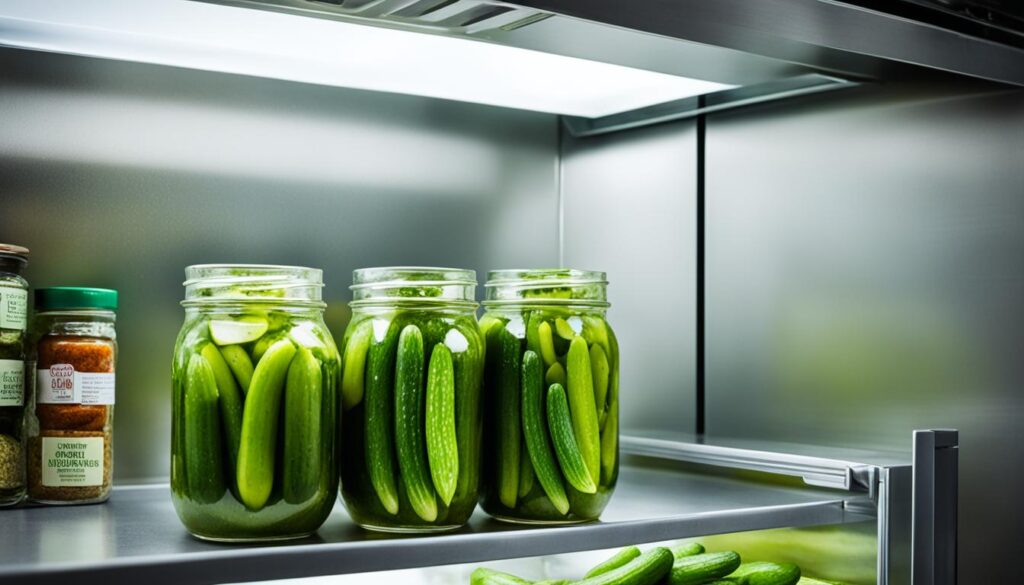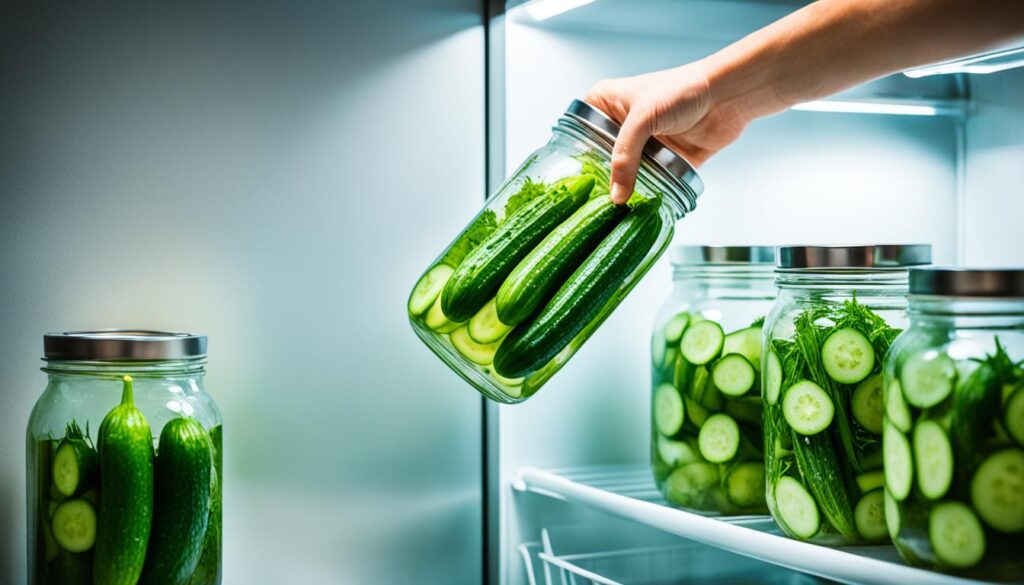Making refrigerator dill pickles at home is a breeze with this easy recipe. The simple brine consists of water, vinegar, sugar, sea salt, garlic cloves, and fresh dill. You can adjust the ratios and add other ingredients to customize the flavor. The pickles can be made with cucumber spears or slices, and they can be stored in the refrigerator for up to one month. The recipe has been highly rated by users and can be enjoyed as a snack or paired with meals like hot dogs or hamburgers.
Key Takeaways:
- Making refrigerator dill pickles at home is easy with this recipe.
- The simple brine consists of water, vinegar, sugar, sea salt, garlic cloves, and fresh dill.
- Cucumbers can be made into spears or slices.
- The pickles can be stored in the refrigerator for up to one month.
- Enjoy them as a snack or pair them with meals like hot dogs or hamburgers.
How to Make Refrigerator Dill Pickles: Step-by-Step Instructions
To satisfy your craving for the best dill pickle recipe, follow these easy steps to create crunchy and tangy refrigerator pickles at home. This refrigerator pickle recipe allows you to customize the flavors while delivering the perfect balance of taste and texture. Let’s get started!
Ingredients:
- 5 cups water
- 2 cups white vinegar
- 1/4 cup sugar
- 1/4 cup sea salt
- 4 garlic cloves, peeled and crushed
- Fresh dill
- 2 pounds pickling cucumbers
Instructions:
- In a saucepan, bring the water, vinegar, sugar, and salt to a boil. Stir until the sugar and salt dissolve. Remove from heat and let the mixture cool completely.
- Meanwhile, wash and dry the pickling cucumbers. Cut them into spears or slices, depending on your preference. Set aside.
- Once the vinegar mixture has cooled, prepare a lidded, refrigerator-safe container. Place the cucumbers, crushed garlic cloves, and fresh dill in the container.
- Pour the cooled vinegar mixture into the container, ensuring that the cucumbers are fully submerged in the brine. Seal the container tightly.
- Refrigerate the container for at least three days to allow the flavors to develop. For the best results, refrigerate the pickles for up to one week, as the longer they sit in the brine, the more flavorful they become.
- When you’re ready to enjoy your homemade tangy dill pickles, take them out of the refrigerator, and serve them chilled. They pair perfectly with sandwiches, burgers, or as a refreshing snack. Store any remaining pickles in the refrigerator for up to one month.
Get ready to savor the satisfaction of biting into crispy dill pickles made with your own hands. Don’t hesitate to experiment with additional ingredients like coriander seeds, peppercorns, or jalapenos to create the best refrigerator dill pickles according to your taste preferences.

The Difference Between Pickling Cucumbers and Other Varieties
When it comes to making homemade pickles, the right choice of cucumbers can make all the difference. Pickling cucumbers, also known as Kirby or pickling cucumbers, are specifically cultivated for pickling due to their unique characteristics. These cucumbers are small in size, firm in texture, and have a thin skin. Additionally, they have smaller seeds and a milder flavor compared to other cucumber varieties.
These characteristics of pickling cucumbers make them the ideal choice for creating crispy and flavorful refrigerator dill pickles. The small size ensures that the pickles retain their crunchiness, while the firm texture holds up well to the brining process. The thin skin allows for better absorption of the brine, resulting in a more flavorful pickle. The smaller seeds also contribute to the overall texture of the pickle, making it more enjoyable to bite into.
While other cucumber varieties, such as slicing cucumbers, can be used for pickling, they may not provide the same level of crunchiness and flavor as pickling cucumbers. Slicing cucumbers tend to have larger seeds and a higher water content, which can lead to softer pickles. However, if pickling cucumbers are not readily available, slicing cucumbers can still be used to make homemade pickles with satisfactory results.
Ultimately, the choice between pickling cucumbers and other varieties depends on personal preference and availability. Experimenting with different cucumbers can yield interesting and unique flavors, allowing you to tailor your pickles to suit your taste. Whether you choose pickling cucumbers or other varieties, the joy of homemade pickles lies in the customization and creativity that goes into making them.
| Cucumber Variety | Characteristics | Best Use |
|---|---|---|
| Pickling Cucumbers | Small size, firm texture, thin skin, smaller seeds, milder flavor | Ideal for making crispy and flavorful refrigerator dill pickles |
| Slicing Cucumbers | Larger seeds, higher water content | Suitable for making pickles if pickling cucumbers are not available |
| Other Varieties | Varies depending on the specific cucumber | Can be used for experimentation and unique flavor profiles |
When making homemade pickles, the fresher the cucumbers, the better the end result. Look for cucumbers that are firm and without blemishes. If possible, opt for locally grown cucumbers or those from your own garden for the freshest and most flavorful pickles.
Tips and Tricks for Perfect Pickles Every Time
To ensure perfect pickles every time, follow these expert tips and tricks:
- Choose small and bumpy pickling cucumbers: Opt for pickling cucumbers that are small in size and have a bumpy texture. These cucumbers are specifically cultivated for pickling and will provide the best texture and flavor for your homemade pickles.
- Experiment with different cuts: Depending on your personal preference, you can cut the cucumbers into rounds, thicker slices, or spears. This allows you to create pickles that suit your desired shape and thickness.
- Add spices for extra flavor: Customize your pickles by adding spices like peppercorns or jalapenos to the brine. This will enhance the flavor profile and give your pickles an extra kick.
- Allow pickles to sit in the brine: For optimal flavor, let your pickles sit in the brine for at least two to three days. This allows the flavors to develop and ensures that each bite is packed with tangy goodness.
- Cool the vinegar mixture completely: Before adding the cucumbers to the brine, make sure the vinegar mixture has completely cooled. This helps preserve the crunchiness of the cucumbers and prevents them from becoming too soft.
- Use cold cucumbers: Always start with cold cucumbers when making pickles. Keeping them cold maintains their crispness and ensures that they retain the perfect texture.
By following these tips and tricks, you’ll be able to achieve perfect pickles every time. Whether you prefer tangy or spicy flavors, homemade pickles made with pickling cucumbers will never disappoint.

| Tip | Description |
|---|---|
| Choose the right cucumbers | Small and bumpy pickling cucumbers provide the best texture and flavor. |
| Experiment with different cuts | Cut the cucumbers into rounds, slices, or spears based on personal preference. |
| Add spices for extra flavor | Customize your pickles with spices like peppercorns or jalapenos. |
| Allow pickles to sit in the brine | Let the pickles sit in the brine for at least two to three days for optimal flavor. |
| Cool the vinegar mixture completely | Ensure the vinegar mixture is completely cooled before adding the cucumbers. |
| Use cold cucumbers | Start with cold cucumbers to maintain their crispness. |
Conclusion
Making delicious refrigerator dill pickles at home is a breeze! With just a handful of ingredients and a little bit of patience, you can create tangy and crunchy pickles that are perfect for snacking or adding a burst of flavor to your favorite meals.
The step-by-step recipe we’ve shared allows for customization, so you can adjust the flavors to suit your taste preferences. Whether you prefer a little extra garlic or a hint of spice, these homemade dill pickles can be tailored to your liking.
By following the expert tips and tricks we’ve provided, you’ll be well on your way to consistently achieving pickle perfection. From choosing the right pickling cucumbers to allowing the flavors to develop in the brine, these simple techniques will ensure that every batch of refrigerator dill pickles is a success.
So why not give it a try? Experience the satisfaction of making your own homemade refrigerator dill pickles and revel in the irresistible taste of these crunchy delights. Once you’ve tasted the freshness and flavor of homemade dill pickles, you’ll never go back to store-bought again!
FAQ
Can I use any type of cucumber to make refrigerator dill pickles?
While other cucumber varieties like slicing cucumbers can be used, pickling cucumbers are specifically cultivated for pickling due to their small size, thin skin, and milder flavor, resulting in crispier and more flavorful pickles.
How long can I store refrigerator dill pickles?
Refrigerator dill pickles can be stored in the refrigerator for up to one month.
Can I customize the flavor of my refrigerator dill pickles?
Yes, the recipe allows for customization. You can adjust the ratios of the ingredients and add additional spices like coriander seeds, peppercorns, or jalapenos to suit your personal taste preferences.
How long do I need to let the pickles sit in the brine?
It is recommended to refrigerate the pickles for at least three days to allow the flavors to develop. The longer the pickles sit in the brine, the more flavorful they will become.
How can I achieve extra crispiness in my refrigerator dill pickles?
To achieve extra crispiness, ensure that the vinegar mixture is completely cooled before adding it to the cucumbers. Using small and bumpy pickling cucumbers, as well as refrigerating the pickles for a minimum of two to three days, will also enhance their crispiness.